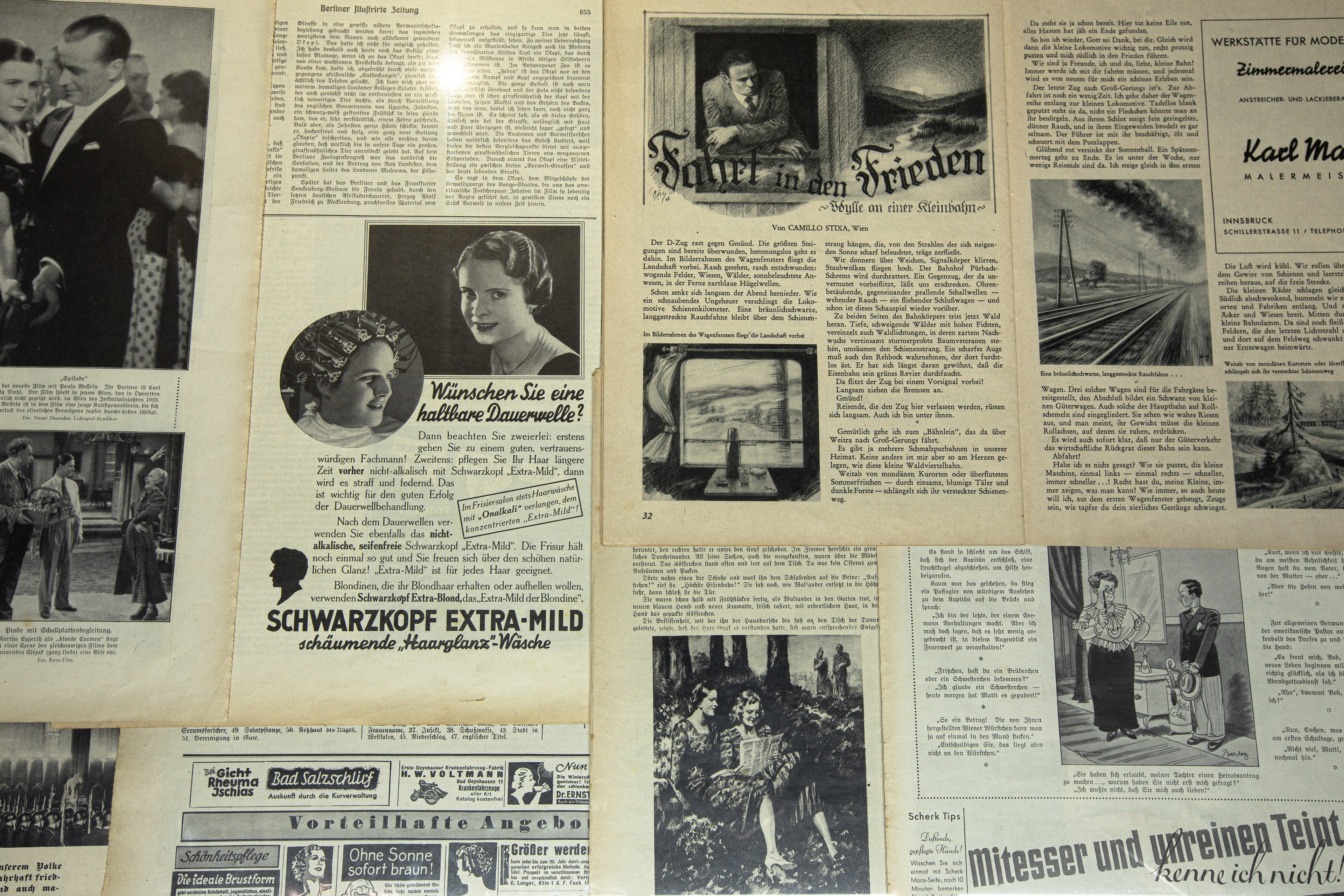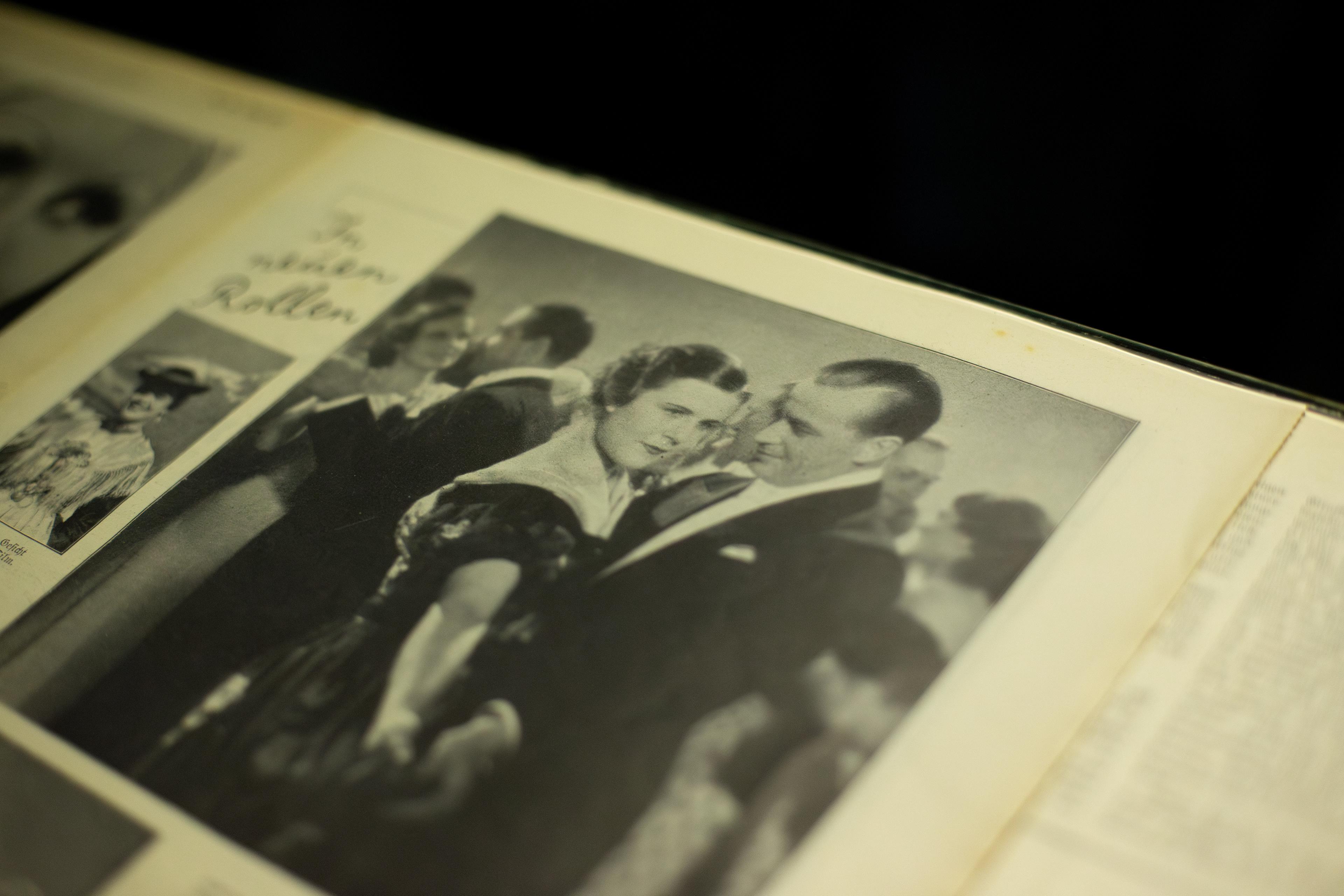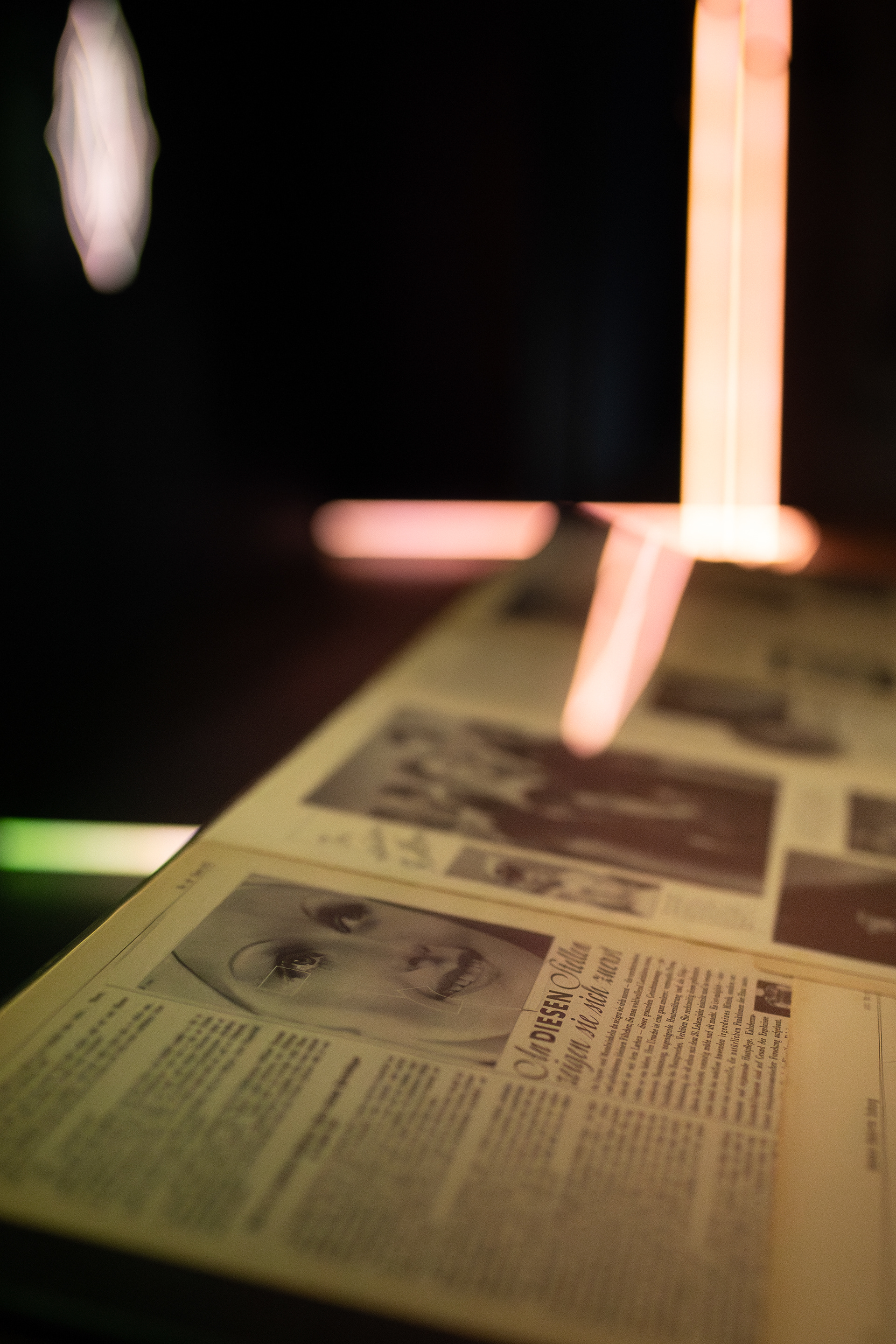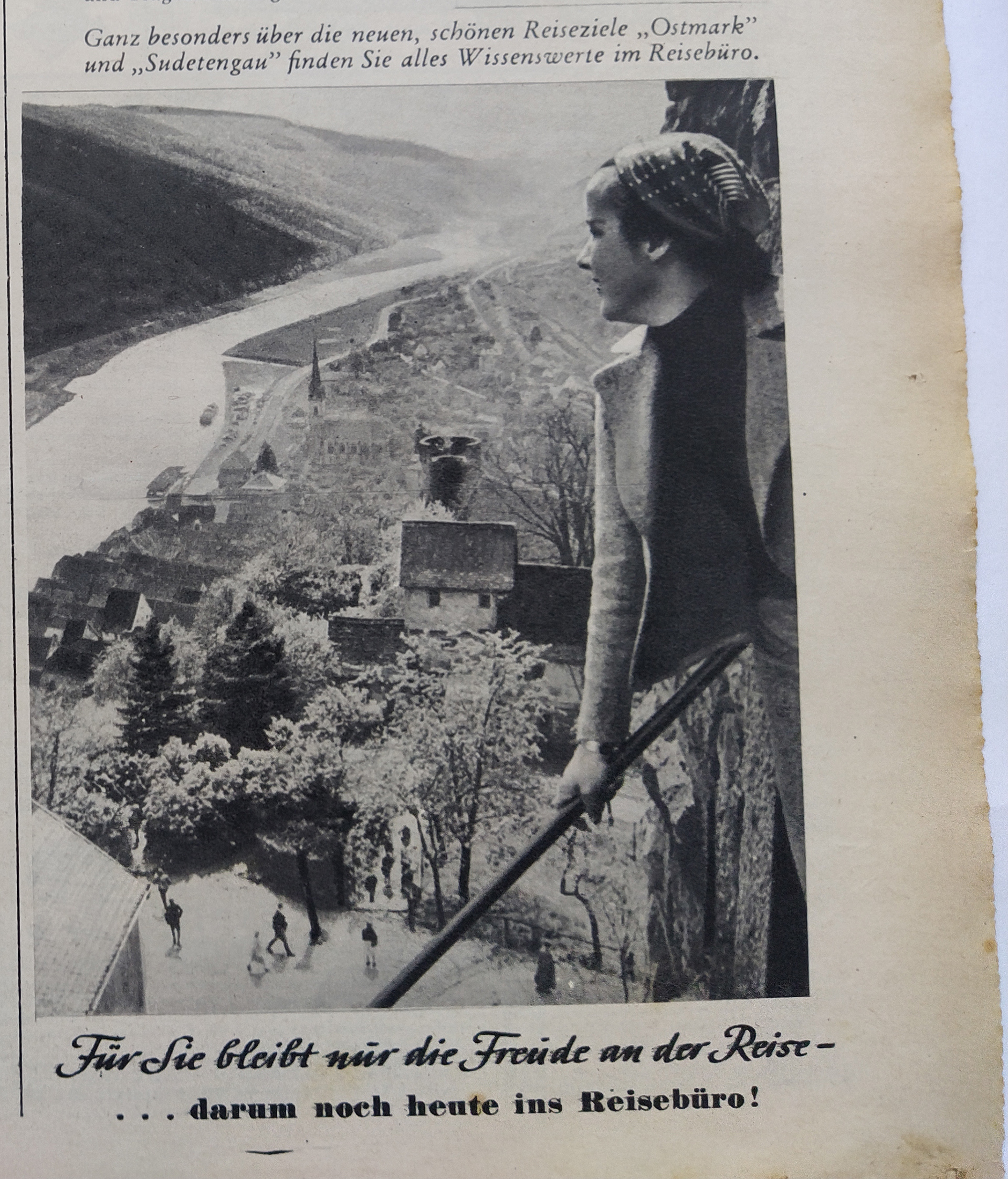instalacja/installation
Wystawa „Krzycz, Siostro, krzycz!”
Kuratorki: Agata Cukierska i Katarzyna Kalina
"Shout, Sister, Shout!" exhibition curated by Agata Cukierska and Katarzyna Kalina
CSW Kronika, Bytom PL
photos: Iwona Sobczyk / CSW Kronika
Kuratorki: Agata Cukierska i Katarzyna Kalina
"Shout, Sister, Shout!" exhibition curated by Agata Cukierska and Katarzyna Kalina
CSW Kronika, Bytom PL
photos: Iwona Sobczyk / CSW Kronika







PL:
„Pozostała jej tylko radość z podróży”
„Pozostała jej tylko radość z podróży”
Instalacja z archiwaliów: lightbox 20x16cm oraz niemieckie i austriackie gazety w podwieszanej gablocie („Berliner Illustrirte Zeitung” Nummer 18, 2. Mai 1935, „Das Illustrierte Blatt. Frankfurter Illustrierte”Nr. 16, 15 April 1939, „Verkehrswirtschaftliche Rundschau” April 1938)
Fur Sie bleibt nur die Freude an der Reise – tak brzmi podpis pod fotografią reklamującą biuro podróży w czasopiśmie „Das Illustrierte Blatt” z kwietnia 1939 roku (wydanie specjalne z okazji 50. urodzin Fürera). Patrząc na obrazek kobiety na tle malowniczej doliny, można by sparafrazować ten tytuł jako: „Pozostała jej tylko radość z podróży”. Jako hasło reklamowe brzmi ono zwyczajnie, jednak jego wymowa może być różna i zależy od kontekstu. Całkowicie inaczej będziemy je odbierać, gdy pomyślimy o rzeczywistości, która tak bardzo zmieniła się w kolejnych latach – gdy pomyślimy o deportacjach i wywózkach ludności żydowskiej do obozów zagłady, zobaczymy ludzi upchanych w wagonach towarowych, niewiedzących jeszcze co ich czeka na końcu podróży. Sam język też ma znaczenie: nazwanie tego podróżą sygnalizuje pewnego rodzaju wyparcie wynikające z odrzucania przez świadomość zbiorową wiedzy o zbrodni (co miało miejsce w czasie II wojny światowej i trwało także, w pewnym stopniu, przez wiele lat w okresie powojennym).
Postać kobiety na tle pejzażu
Malarstwo pejzażowe, tak bardzo lubiane przez nazistów, przedstawiało piękno przyrody, krajobrazy górskie (znane są także akwarele autorstwa samego Adolfa Hitlera przedstawiające alpejskie widoki), lasy, niewielkie wioski, jaki i dalekie otwarte przestrzenie. Dla nazistów, odzwierciedlające zarówno duszę Ludu (Volk) jak i rozległe tereny przestrzeni życiowej (Lebensraum) potrzebnej III Rzeszy. Pędzący w przestrzeń pociąg, jaki zobaczymy na stronach gazet z tamtego okresu, możemy odczytywać jako symptom ówczesnego ekspansjonizmu. W naszej opowieści postać kobiety na tle pejzażu ostatecznie znika z obrazu – jej dusza nie przynależy do duszy Ludu.
Więcej o koncepcji wystawy: https://kronika.org.pl/wystawy/krzycz-siostro-krzycz-wystawa
Malarstwo pejzażowe, tak bardzo lubiane przez nazistów, przedstawiało piękno przyrody, krajobrazy górskie (znane są także akwarele autorstwa samego Adolfa Hitlera przedstawiające alpejskie widoki), lasy, niewielkie wioski, jaki i dalekie otwarte przestrzenie. Dla nazistów, odzwierciedlające zarówno duszę Ludu (Volk) jak i rozległe tereny przestrzeni życiowej (Lebensraum) potrzebnej III Rzeszy. Pędzący w przestrzeń pociąg, jaki zobaczymy na stronach gazet z tamtego okresu, możemy odczytywać jako symptom ówczesnego ekspansjonizmu. W naszej opowieści postać kobiety na tle pejzażu ostatecznie znika z obrazu – jej dusza nie przynależy do duszy Ludu.
Więcej o koncepcji wystawy: https://kronika.org.pl/wystawy/krzycz-siostro-krzycz-wystawa
EN:
"Only the joy of the journey remains for her."
Installation featuring archival materials: a 20x16cm lightbox and German and Austrian newspapers in a suspended display case. („Berliner Illustrirte Zeitung” Nummer 18, 2. Mai 1935, „Das Illustrierte Blatt. Frankfurter Illustrierte”Nr. 16, 15 April 1939, „Verkehrswirtschaftliche Rundschau” April 1938)
"Only the joy of the journey remains for her."
Installation featuring archival materials: a 20x16cm lightbox and German and Austrian newspapers in a suspended display case. („Berliner Illustrirte Zeitung” Nummer 18, 2. Mai 1935, „Das Illustrierte Blatt. Frankfurter Illustrierte”Nr. 16, 15 April 1939, „Verkehrswirtschaftliche Rundschau” April 1938)
Fur Sie bleibt nur die Freude an der Reise – such is the caption beneath a photograph advertising a travel agency in the April 1939 issue of 'Das Illustrierte Blatt' (special edition marking the Führer's 50th birthday). Looking at the image of a woman against the backdrop of a picturesque valley, one could paraphrase this title as: 'Her only remaining joy was from the journey.' As an advertising slogan, it sounds ordinary, but its meaning can vary depending on the context. We interpret it entirely differently when we think about the reality that changed so much in subsequent years – when we consider deportations and the transport of Jewish people to extermination camps, seeing people crammed into freight cars, unaware of what awaits them at the end of the journey. The language itself matters: calling this a journey signals a kind of repression stemming from the collective consciousness' rejection of knowledge of the crime (which occurred during World War II and persisted to some extent for many years in the post-war period).
The Figure of the Woman Against the Landscape
Landscape painting, greatly admired by the Nazis, depicted the beauty of nature, mountainous landscapes (there are also watercolors by Adolf Hitler himself depicting Alpine views), forests, small villages, and vast open spaces. For the Nazis, these landscapes reflected both the soul of the Volk (people) and the expansive living space (Lebensraum) needed for the Third Reich. The train speeding into the distance that we see in newspapers from that time can be interpreted as a symptom of the expansionism of that era. In our story, the figure of the woman against the landscape ultimately fades from the picture – her soul does not belong to the soul of the Volk.
More about the exhibition concept: https://kronika.org.pl/en/exhibitions/shout-sister-shout-wystawa
Landscape painting, greatly admired by the Nazis, depicted the beauty of nature, mountainous landscapes (there are also watercolors by Adolf Hitler himself depicting Alpine views), forests, small villages, and vast open spaces. For the Nazis, these landscapes reflected both the soul of the Volk (people) and the expansive living space (Lebensraum) needed for the Third Reich. The train speeding into the distance that we see in newspapers from that time can be interpreted as a symptom of the expansionism of that era. In our story, the figure of the woman against the landscape ultimately fades from the picture – her soul does not belong to the soul of the Volk.
More about the exhibition concept: https://kronika.org.pl/en/exhibitions/shout-sister-shout-wystawa